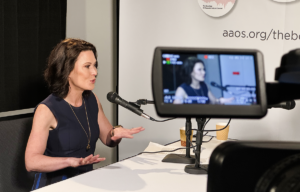Now that you’re set up, what will you Tweet?

So, you’ve got a Twitter account, a username, a bio and you’ve followed key people and organizations in your community. You also may have the reins to your organization’s main Twitter page if you’ve been tasked to Tweet on behalf of the entire company.
Now, what to Tweet?… And, what not to Tweet?
A knee jerk reaction for many of us is to post headline after headline after headline. Many a journalist has done it. That’s how many people started using Twitter back in the day. When using your individual account, leave the bulk of those headline Tweets to your organization’s flagship Twitter account.
Today, you are giving readers the experience of living vicariously through you by seeing the news manifest over time. And, they will have opportunities to engage with you in a variety of ways, which drives traffic, a higher appreciation of your hard work, loyalty to your byline and increases your pool of sources. By the way, people love behind-the-scenes pictures and videos. Have a picture of everyone working a big story in the newsroom? Are you at a fire and have pictures of all the other media scrambling to interview the fire chief? Are you eating lunch at your desk again because you have a deadline to hit? (These are great opportunities for Instagram Live too!)
Your organization’s main Twitter account is the home for breaking news and sharing or ReTweeting the “best of” your team’s stories, photos and videos. It is also a place to respond to followers’ questions and comments (even with a simple “Thanks!”). Here you can share compelling quotes from stories, hard data and context, which inspire followers to go to your news site for more.
Getting started
Let’s walk through how to use Twitter.
Click on “Home,” in the upper left menu bar. Once you’re home, you’ll see the question “What’s happening?” below the menu. This is where you will enter your Tweets.
First, know that Tweets are a maximum of 280 characters. This was previously limited to 140 characters, which was daunting to many. But, as journalists you are primed for this by exercising the brain muscles you use to write your ledes.
If you absolutely cannot find a way around the word limit, Twitter offers an option to hit the “+” button next to the “Tweet” button to write a series of Tweets. This is also known as a “thread,” a tool you can use to create a feed on a developing story.
When and how much to Tweet
In general, on your personal Twitter accounts, it is good practice to Tweet at least once a day and at 3 p.m. to garner the best engagement with you and your news site, according to an analysis of 40,000 Tweets from @Hootsuite (that’s the Twitter account of the social media management tool).
What to Tweet
Here’s what to Tweet or Retweet from your individual professional account:
- Select compelling stories, photos or a brief video by you or your colleagues, which are linked to your news site. These elements highly increase engagement and traffic through ReTweets. The most successful imagery on Twitter capture crucial or emotional footage, as well as the funny, surprising or bizarre.
- Hard data, which adds valuable credibility.
- Share what is developing on your news site and in your beat – whether you are on your way to a controversial school board meeting, major protest or a colleague is on a crime scene. For breaking news, the audience on Twitter wants to know what is happening now, and followers want valuable updates from a verified, objective resource.
- Ask for reactions to issues and events, and make call-outs for sources to stories. You will be surprised by what you receive.
- Respond to your followers’ questions and comments. You can do this by hitting the “reply” button on a Tweet.
- And, mention people or accounts by typing the “@” button before a username. This also links your Tweet to the account of the person you mentioned.
Here are some good examples of what to Tweet:
Hashtag ethics and what not to Tweet
In the body of a Tweet, a # symbol can be entered before a word or phrase to create a hashtag. By doing this, people will click on your hashtag and pull up other Tweets containing the same keyword or topic. Vice versa, this also means people can find your Tweet and link to your story by entering the hashtag into a search.
It’s exciting to give Tweets a boost into the global stream with this tool, but the overuse and inappropriate use of hashtags #are #not #only #annoying #to followers, but also are considered to be unethical.
Hashtags are often construed as editorializing. If there is a trending hashtag surrounding a major event, take time to discuss with your news team whether the use of it creates the illusion that you or your news organization are aligning with one side or another on the event or issue.
Instead, if an objective hashtag is not already visible, make one to create a pool of reliable and objective information. This raises the reputation of your news organization even higher by being the trendsetter.
Lastly on what not to Tweet, polls, GIFs and emojis are also options for adding to Tweets. However, it probably goes without saying that Twitter polls are not scientific and you probably won’t post many GIFs or emojis from your individual account or your organization’s account, as those can be seen in the same vein as editorializing hashtags.
For more on Twitter terms, go to its glossary and read more on Twitter basics.
Now that you know when to Tweet, how much and what to Tweet, go ahead and start tweeting.
Are you Tweeting for the newspaper’s account? Want to know how to get more retweets and make sure people are actually clicking on the story?
Look out for more this week on using Twitter’s advanced search function, how to gain new followers, how to create lists and pull analytics to see what’s working and what isn’t.





